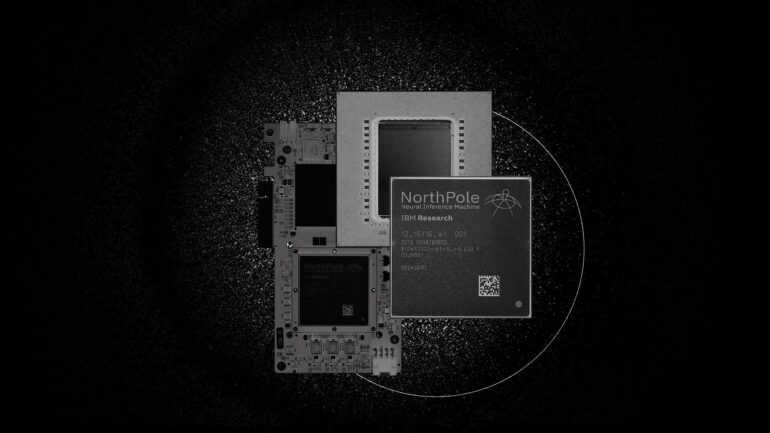TL;DR:
- IBM unveils NorthPole microchip, potentially transforming AI and military tech.
- NorthPole chip combines memory and processing, mimicking the human brain.
- Addresses energy inefficiency and transistor limitations in current computers.
- 22 billion transistors, 256 cores, and exceptional efficiency.
- Pentagon heavily invested due to potential military applications.
- Smarter, network-independent chips with diverse sensory capabilities.
- Potential to reduce reliance on foreign microprocessor supply chains.
Main AI News:
In a groundbreaking revelation, IBM unveiled a prototype microchip design poised to redefine the landscape of artificial intelligence (AI). This innovation promises to usher in a new era of exceptionally intelligent devices, eliminating their dependency on the cloud or internet connectivity. Such a leap forward holds tremendous potential for soldiers operating drones, ground robots, and augmented-reality equipment in the face of adversaries skilled in targeting electronic emissions. Moreover, the NorthPole chip, inspired by the intricacies of the human brain, presents an alternative path for AI development, one that liberates it from the dominance of tech giants like Amazon and Google.
Traditionally, computer systems have grappled with two significant limitations hindering AI evolution. Firstly, they consume vast amounts of power. Comparatively, the human brain operates on a mere 12 watts, effortlessly handling complex tasks such as maintaining conversations and processing extensive sensory data for activities like driving. In stark contrast, a typical desktop computer devours a whopping 175 watts merely to execute basic spreadsheet operations. This energy inefficiency stands as a major obstacle for implementing computer vision in vehicles and drones, posing a substantial constraint on achieving autonomy. It’s also responsible for the colossal energy consumption of today’s AI tools hosted in massive enterprise cloud data centers, equivalent to powering an entire small town.
Secondly, we’ve approached the atomic threshold regarding the number of transistors that can be integrated into a chip. The NorthPole chip prototype emerges as a potential remedy for both of these challenges. IBM’s senior fellow, Dharmendra S. Modha, emphasizes the chip’s optimization in terms of energy, space, and time, presenting a promising solution to these pressing issues.
The NorthPole chip boasts an impressive 22 billion transistors and 256 cores, a remarkable feat in its own right. However, its unique architecture allows it to perform exponentially more efficiently in tasks such as processing dynamic images when compared to a chip of similar transistor count utilizing 12nm silicon technology. This advancement promises to significantly shrink the footprint of enterprise cloud environments, potentially revolutionizing cloud computing to a portable scale. In addition to enterprise applications, the NorthPole chip can cater to the needs of smaller drones and robots, reducing the hardware requirements substantially.
The Pentagon’s keen interest in this groundbreaking technology underscores its potential significance. IBM’s decade-long pursuit of neuromorphic chips, funded by DARPA’s SyNAPSE program, has garnered substantial investments, with the Department of Defense injecting over $90 million since 2019. This patient capital investment reflects the DOD’s emphasis on low power consumption, reduced size, weight, and increased processing speed, all vital attributes, especially in contested environments where signal interference is a concern.
Smarter, network-independent chips could revolutionize various military systems, enhancing their ability to perceive and interpret their surroundings. These chips enable the integration of diverse data types, including audio, optical, infrared, sonar, and LiDAR, and may even facilitate the creation of novel sensors like “micropower impulse radar.” Importantly, these chips operate independently of the internet, making them suitable for various applications, including self-driving cars.
Multiple military laboratories, such as the Air Force Research Lab and Sandia National Lab, are actively exploring potential applications of the NorthPole prototype chip. Additionally, the chip’s efficiency could enable the military to accomplish more with fewer domestically producible chips—a crucial consideration given the growing concerns about supply chain vulnerabilities, particularly regarding advanced microprocessors.
Despite the chip’s impressive performance, the United States must bolster its capabilities to mass-produce such chips, a critical process that has only just commenced. As we descend the technology node curve to single-digit nanometers, the NorthPole chip’s potential for even better performance becomes increasingly evident, further fueling excitement about its future applications.
Conclusion:
The NorthPole microchip’s breakthrough has far-reaching implications for the market. Its unique architecture promises to revolutionize AI and defense technology by significantly improving energy efficiency, transcending transistor limitations, and offering diverse applications. The Pentagon’s investment underscores its relevance in military contexts, and the chip’s independence from internet connectivity opens doors to innovation across various sectors. As the chip’s performance continues to evolve, it could reduce reliance on overseas chip suppliers and reshape the competitive landscape in both the technology and defense industries.

